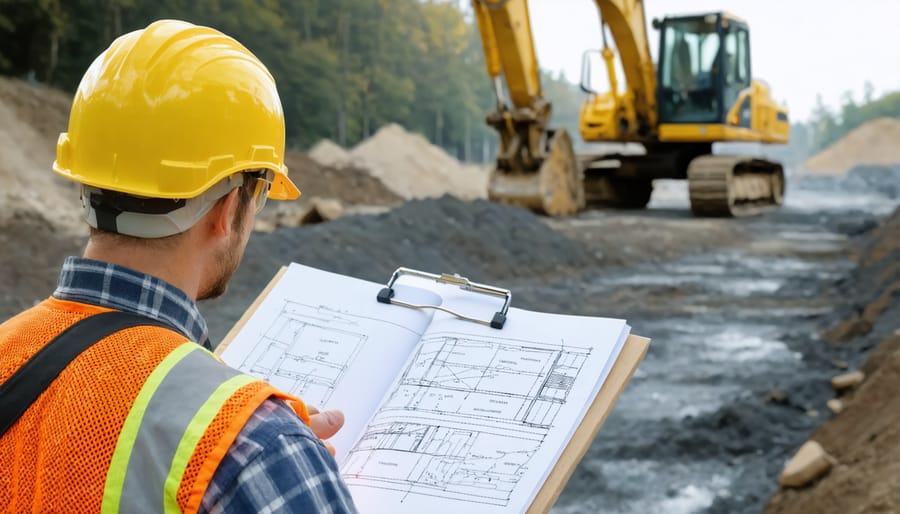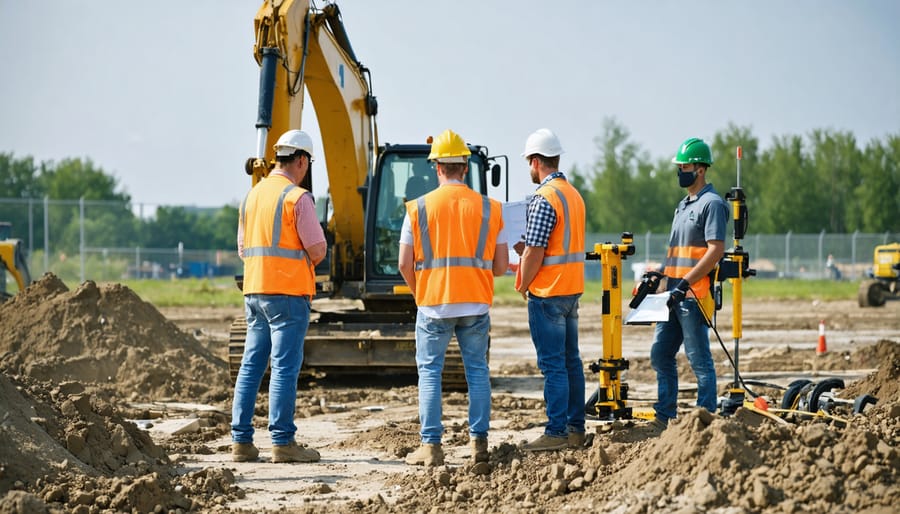Construction industry regulations form the critical foundation of safe, legal, and sustainable building practices across the globe. These comprehensive frameworks govern everything from workplace safety protocols and environmental protection measures to building codes and material specifications. In today’s complex construction landscape, understanding and complying with these regulations isn’t just about avoiding penalties—it’s about ensuring project success, protecting worker safety, and delivering quality infrastructure that stands the test of time.
The regulatory environment in construction has evolved significantly over the past decades, driven by technological advances, environmental concerns, and lessons learned from past failures. Modern construction regulations encompass multiple layers of oversight, including federal mandates, state-specific requirements, local building codes, and industry-specific standards. These regulations serve as both a safety net and a roadmap, guiding construction professionals through the intricate process of bringing projects from concept to completion while maintaining strict safety and quality standards.
For construction professionals, staying current with these regulations represents both a challenge and an opportunity. While compliance demands careful attention to detail and ongoing education, it also provides a structured framework for excellence in construction practices, risk management, and project execution.

Core Building Safety Regulations
Building Codes and Standards
Building codes and standards form the cornerstone of construction industry regulations, establishing minimum requirements for safety, structural integrity, and performance. The International Building Code (IBC) serves as the primary model code in the United States, with state and local jurisdictions adopting and modifying these standards to meet regional needs. These comprehensive building code classifications cover essential aspects including structural design, fire protection, accessibility, and energy efficiency.
Local building departments enforce these regulations through plan reviews and inspections throughout the construction process. Codes typically address specific requirements for different occupancy types, construction materials, mechanical systems, electrical installations, and plumbing networks. They also incorporate standards from organizations like ASTM International, ASHRAE, and NFPA to ensure technical specifications meet industry benchmarks.
Regular updates to building codes reflect technological advances, lessons learned from disasters, and evolving safety requirements. Construction professionals must stay current with these changes, as compliance is mandatory and violations can result in project delays, costly modifications, or legal consequences. Many jurisdictions now also include provisions for sustainable construction practices and resilient design strategies, addressing modern environmental concerns while maintaining traditional safety standards.
Health and Safety Requirements
Health and safety requirements form the cornerstone of construction industry regulations, with OSHA safety regulations establishing mandatory standards for workplace safety and health protection. These requirements encompass fall protection systems, proper scaffolding installation, respiratory protection, and adequate personal protective equipment (PPE) for all workers.
Construction sites must maintain comprehensive safety programs that include regular safety training, hazard communication protocols, and emergency response procedures. Employers are required to conduct routine safety inspections, document incidents, and implement corrective measures to prevent future accidents. Special attention must be given to confined space entry procedures, electrical safety protocols, and proper handling of hazardous materials.
Site-specific safety plans must address unique project risks and establish clear communication channels for reporting safety concerns. These plans should include detailed procedures for equipment operation, material handling, and workplace ergonomics. Regular safety meetings and toolbox talks are mandatory to ensure all workers remain informed about current safety protocols and emerging hazards.
Companies must also maintain detailed records of safety training, incident reports, and corrective actions to demonstrate compliance with regulatory requirements. Failure to meet these safety standards can result in significant penalties, project delays, and potential legal liability.
Environmental Compliance Requirements
Environmental Impact Assessments
Environmental Impact Assessments (EIAs) are mandatory evaluations required for construction projects that may significantly affect the natural environment. These assessments examine potential environmental consequences before construction begins and are typically required by local, state, and federal regulatory bodies.
The assessment process involves several key components, including baseline environmental studies, impact prediction, and mitigation planning. Projects must evaluate effects on air quality, water resources, soil conditions, wildlife habitats, and local ecosystems. Large-scale developments often require comprehensive Environmental Impact Statements (EIS), which demand more detailed analysis and public review periods.
Construction firms must obtain environmental permits before breaking ground, with requirements varying by project scope and location. Common permits include:
– Clean Water Act permits for projects affecting water bodies
– Air quality permits for dust and emissions control
– Wetland development permits
– Endangered species impact permits
– Stormwater management permits
Contractors must implement specific environmental protection measures throughout construction, including:
– Erosion and sediment control
– Waste management protocols
– Protected species monitoring
– Air quality control measures
– Noise pollution reduction strategies
Non-compliance with EIA requirements can result in substantial fines, project delays, or work stoppages. Regular environmental audits and documentation are essential for maintaining compliance and demonstrating due diligence throughout the construction process.

Waste Management and Sustainability
Construction waste management regulations have become increasingly stringent, reflecting growing environmental concerns and the industry’s significant environmental impact. The Environmental Protection Agency (EPA) mandates specific requirements for construction and demolition (C&D) waste handling, including proper segregation, documentation, and disposal procedures.
Key regulations require contractors to implement comprehensive waste management plans that detail waste reduction strategies, recycling protocols, and disposal methods. These plans must typically achieve minimum diversion rates, often ranging from 50% to 75% of construction waste, depending on local jurisdiction requirements.
The integration of sustainable construction practices has become mandatory in many regions, with regulations requiring the use of recycled materials, implementation of energy-efficient designs, and adoption of water conservation measures. LEED certification requirements and similar green building standards often influence these regulations.
Hazardous waste management in construction faces particularly strict oversight, with specific protocols for handling materials like asbestos, lead-based paint, and chemical solvents. Contractors must maintain detailed records of waste disposal, including manifests and chain-of-custody documentation, and ensure proper training for personnel handling these materials.
Non-compliance with waste management regulations can result in substantial fines, project delays, and potential legal action. Regular audits and inspections by environmental agencies ensure adherence to these requirements, making proper waste management essential for project success and regulatory compliance.
Labor and Employment Regulations
Worker Classification and Rights
Worker classification in the construction industry is governed by strict federal and state regulations that determine employment status, rights, and protections. Employers must correctly categorize workers as either employees or independent contractors, as misclassification can result in severe penalties and legal consequences. The distinction affects various aspects of employment, including wage requirements, benefits, and regulatory compliance requirements.
For employees, employers must provide workers’ compensation insurance, unemployment benefits, and adhere to minimum wage and overtime regulations under the Fair Labor Standards Act (FLSA). Additionally, construction workers are entitled to safe working conditions as mandated by OSHA, proper safety training, and appropriate personal protective equipment (PPE).
Union workers receive additional protections through collective bargaining agreements, which typically establish wage scales, work hours, and specific working conditions. Employers must also comply with the Davis-Bacon Act for federal construction projects, ensuring workers receive prevailing wages and benefits for their locality.
Training and Certification Requirements
Construction workers must meet specific training and certification requirements to ensure workplace safety and regulatory compliance. OSHA mandates that workers complete safety training programs relevant to their roles, including fall protection, hazard communication, and equipment operation. Key certifications include the OSHA 10-hour course for entry-level workers and the OSHA 30-hour course for supervisors and safety personnel.
Specialized certifications are required for specific tasks: crane operators must obtain certification from accredited organizations like NCCCO, while welders need AWS certification. Workers handling hazardous materials must complete HAZWOPER training, and those working with lead or asbestos require additional specialized certifications.
Many states impose additional requirements beyond federal standards. For instance, some jurisdictions mandate site safety training cards or specific trade licenses. Regular renewal of certifications and ongoing safety training are typically required to maintain compliance. Employers must maintain detailed records of all worker certifications and training completions, which may be subject to inspection during regulatory audits.
Project managers and supervisors often need additional qualifications, including construction management certifications and specific safety coordinator credentials, to oversee regulatory compliance effectively.

Compliance and Enforcement
Inspection and Documentation
Construction projects require rigorous inspection and documentation processes to ensure compliance with regulatory standards. These processes typically occur at critical phases of construction, including foundation work, structural framework, electrical systems, plumbing installations, and final completion.
Building inspectors must verify that all work meets local building codes and safety requirements. They conduct scheduled inspections at predetermined milestones and may perform surprise visits to ensure ongoing compliance. Documentation requirements include detailed records of inspections, test results, material certifications, and any corrective actions taken.
Key documentation typically includes:
– Building permits and approvals
– Inspection certificates
– Safety audit reports
– Material safety data sheets (MSDS)
– Quality control records
– Environmental compliance documents
– Worker certification and training records
– As-built drawings and specifications
Digital documentation systems are increasingly becoming standard practice, allowing for better organization, accessibility, and compliance tracking. These systems help maintain detailed records of construction progress, changes, and regulatory adherence throughout the project lifecycle.
Contractors must maintain these records for specified periods, often several years after project completion, to address potential liability issues and demonstrate regulatory compliance during audits or investigations. Regular internal audits of documentation processes help ensure completeness and accuracy of records while identifying areas for improvement in compliance procedures.
Penalties and Consequences
Non-compliance with construction industry regulations can result in severe consequences, ranging from financial penalties to criminal prosecution. Regulatory violations typically incur substantial fines, which can range from thousands to millions of dollars, depending on the severity and frequency of the infractions. For major safety violations, companies may face penalties of up to $145,027 per violation under OSHA regulations.
Beyond monetary penalties, regulatory breaches can lead to project shutdowns, suspension of construction permits, and mandatory work stoppages until violations are remediated. Serious violations may result in the revocation of contractor licenses or professional certifications, effectively preventing companies from bidding on future projects.
Criminal prosecution is possible in cases of willful negligence or repeated serious violations, particularly when they result in injuries or fatalities. Company executives and project managers may face personal liability, including potential imprisonment for egregious violations.
Additional consequences include increased insurance premiums, damaged reputation, loss of client trust, and reduced competitiveness in bidding processes. Companies may also face civil lawsuits from affected parties, leading to significant legal expenses and settlement costs. The indirect costs of non-compliance, such as project delays, remediation expenses, and lost business opportunities, often far exceed the initial penalties imposed by regulatory authorities.
Future Regulatory Trends
The construction industry is poised for significant regulatory evolution in the coming years, driven by technological advancements, environmental concerns, and changing societal needs. One of the most prominent trends is the increasing focus on sustainable construction practices, with many jurisdictions implementing stricter energy efficiency requirements and green building standards. These regulations are expected to mandate higher performance materials, enhanced insulation requirements, and more efficient building systems.
Digital transformation is also reshaping regulatory compliance, with many authorities transitioning to automated permit processing and digital plan reviews. Building Information Modeling (BIM) mandates are becoming more common, particularly for large-scale public projects, requiring contractors to maintain detailed digital documentation throughout the construction lifecycle.
Safety regulations are evolving to address emerging challenges, including the integration of autonomous equipment and drones on construction sites. New guidelines for worker protection in relation to these technologies are being developed, along with updated protocols for remote work supervision and virtual inspections.
Climate resilience is another key area of regulatory development. Future building codes will likely include more stringent requirements for weather resistance, flood protection, and disaster preparedness. These changes reflect the growing need to adapt construction practices to extreme weather events and changing environmental conditions.
Labor regulations are also shifting, with increased emphasis on workforce development and certification requirements. Industry experts anticipate new standards for skilled labor qualifications, apprenticeship programs, and continuing education requirements for construction professionals.
Additionally, modular and prefabricated construction methods are gaining regulatory attention, with authorities developing specific guidelines for quality control, transportation, and installation of these building components.
Construction industry regulations form the backbone of safe, sustainable, and compliant building practices. As we’ve explored, these regulations encompass various critical areas, from workplace safety and environmental protection to building codes and labor standards. Staying current with these regulations is not merely a legal obligation but a fundamental aspect of successful project delivery and risk management.
Professional construction leaders must recognize that regulatory compliance is an ongoing process requiring constant attention and updates. The dynamic nature of the construction industry, coupled with evolving technological capabilities and environmental concerns, continues to shape regulatory frameworks worldwide.
To maintain compliance and industry leadership, organizations should implement robust regulatory monitoring systems, invest in regular staff training, and establish clear communication channels with regulatory bodies. The cost of non-compliance – both financial and reputational – far outweighs the investment required for proper regulatory adherence.
Remember that regulations exist not only to ensure safety and quality but also to drive industry innovation and sustainable practices. By embracing and staying ahead of regulatory requirements, construction professionals can better serve their clients, protect their workers, and contribute to the industry’s advancement while maintaining competitive advantage in an increasingly complex marketplace.

